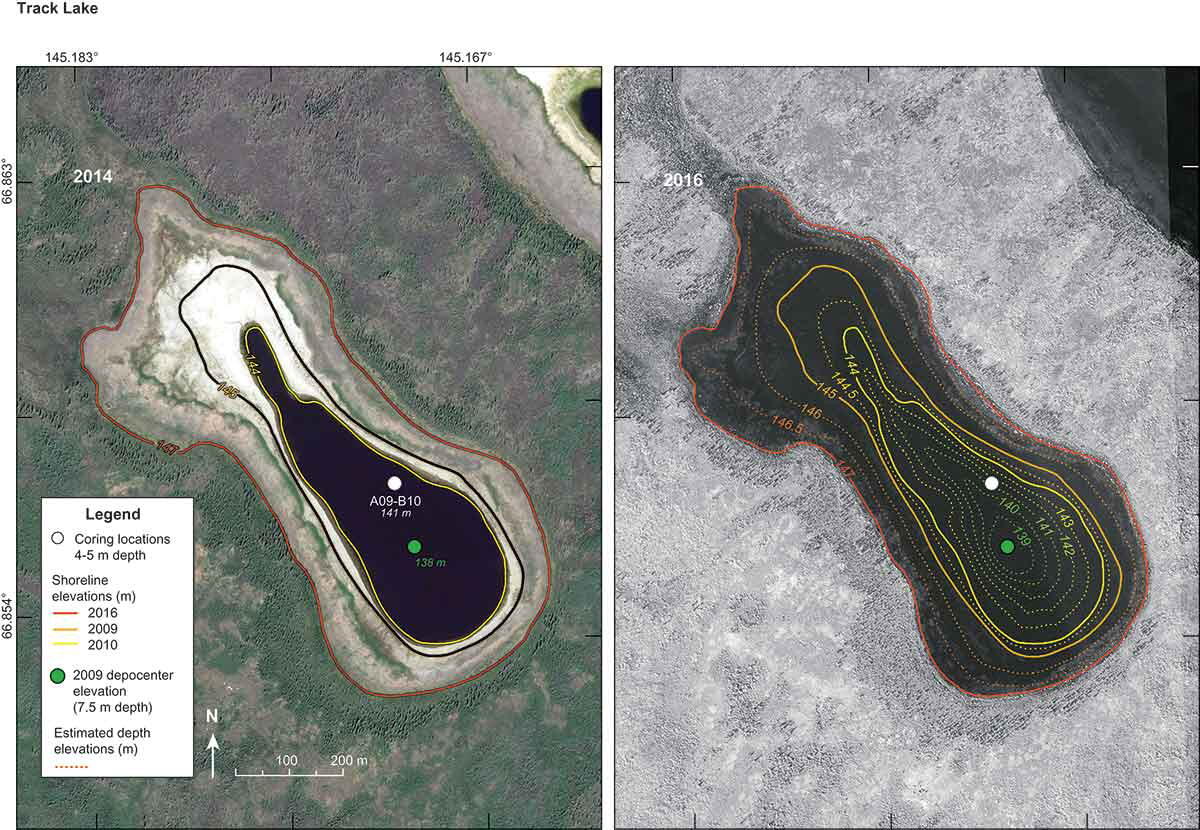Tracking long term changes in lake levels within permafrost regions of Alaska
This article is part of the Spring 2019 issue of the Earth Science Matters Newsletter.
Lakes in permafrost (frozen ground) across arctic and sub-arctic regions provide habitat for waterfowl, offer productive breeding areas, promote aquatic production, and play key roles in cycling of nutrients and water. As such, they have regional to global implications for ecosystems, carbon, wildlife, and infrastructure. Lakes formed from thawing permafrost (thermokarst lakes) have been an agent of landscape change for millennia, and their evolution reflects the complex interplay of climate, vegetation, hydrology, and fire.
Between the late 1980s and 2014, sustained thermokarst lake-level declines occurred in Alaska’s Yukon Flats National Wildlife Refuge, raising questions about the significance of persistent lake level declines, their relationship to precipitation and temperature trends, and the subsequent effects on the region’s highly productive waterfowl breeding habitat. The lake level declines reversed within a 13-month period from 2015 to 2016, when higher-than-average precipitation resulted in the recovery by most lakes to maximum levels, including two intensive study sites. These high levels persisted at least through the summer of 2018. Instrumental measurements of lake level are limited so there are no data prior to the early 1950s to indicate whether such extreme lake-level variations are typical for Yukon Flats thermokarst lakes.
Scientists from the USGS and Idaho State University set out to document changes in thermokarst lake-level dynamics over decades, centuries, and millennia by sampling lake water and sediment cores. By combining modern observations with high-resolution records of past lake-level change, the researchers are placing recent extremes into a longer-term context and providing new insights on how lake levels in Alaska may evolve in the future.
Estimates of past precipitation and evaporation within lakes can be made from geochemical signatures contained in the minerals of their sedimentary deposits. One such signature, the oxygen isotope ratio, compares the abundance of two stable oxygen isotopes in carbonate: 18O and 16O. In lakes that lose significant amounts of water by evaporation, the lighter 16O isotope is lost in evaporated water molecules so that the remaining lake water has more of the heavier 18O isotope. Therefore, higher ratios reflect more evaporation relative to precipitation, such as in drier periods, whereas lower ratios record less evaporation and a wetter climate.
The oxygen isotope record of past lake water is preserved layer-by-layer within lake sediment minerals, and measurement on incremental samples provided continuous records of past hydroclimate from two lakes, Track Lake and Twelvemile Lake. The Track Lake record spans the past ~5,000 years and indicates that high-magnitude lake-level variations had frequently occurred on multi-annual to decadal time scales before the observational period. Such extremes are persistent hydroclimatic features of the Yukon Flats region. This study shows that by framing recent lake-level fluctuations within a longer-term context, we can more confidently identify the occurrence of abnormally sustained trends, which provides essential insight to future impacts on high-latitude wetland ecosystems, permafrost, and carbon.
The paper “Lake levels in a discontinuous permafrost landscape: Late Holocene variations inferred from sediment oxygen isotopes, Yukon Flats, Alaska” was published in Arctic, Antarctic, and Alpine Research.



